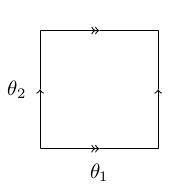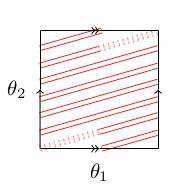Any compact matrix group G contains a compact abelian matrix group which is (a) path-connected and (b) nontrivial.
Optional: Finding compact abelian subgroups
Compact abelian subgroups exist
This video is optional.
In the next video, we'll see that any compact, path-connected abelian group is a torus, so together these results will show that G contains a nontrivial torus.
Let little h inside little g be a nontrivial abelian subalgebra, that is a subspace of little g on which the commutator bracket vanishes.
Note that there is always a nontrivial abelian subalgebra if little g is nontrivial, for example a line in little g is a nontrivial abelian subalgebra: suppose we look at the line spanned by X in little g, then any two elements lambda_1 X and lambda_2 X of this line commute with one another.
We now make two claims:
-
exp of little h, that is the set of exp X as X varies of little h is an abelian subgroup of G.
-
while exp of little h is not necessarily compact, its topological closure exp of little h, all bar is a compact abelian subgroup.
Together, these claims will prove the proposition (we just need to take the path-component of the identity in exp of little h, all bar).
To prove claim 1, we observe that exp X_1 exp X_2 equals exp of X_1 plus X_2 for all X_1 and X_2 in little h because X_1 and X_2 commute. This implies that exp of little h is a subgroup of G, because if exp of X_1 is in exp of little h and exp of X_2 is in exp of little h then exp X_1 exp X_2 equals exp of X_1 + X_2 and X_1 + X_2 is in little h because little h is a subspace.
Moreover, exp of little h is abelian, because: exp of X_1 times exp of X_2 equals exp of X_1 plus X_2, equals exp of X_2 plus X_2, equals exp of X_2 times exp of X_1.
To prove claim 2, we showed earlier (as an exercise) that the topological closure of a subgroup is a subgroup, so we just need to show that exp of little h, all bar is compact and abelian. The fact that it's compact follows from the fact that it's closed (by construction) and contained in a compact set (the compact group G), and it's a general fact from point-set topology that a closed subset of a compact set is compact. (This is clear for us because "compact" means "closed and bounded", and a subset of a bounded set is bounded).
So the key thing to check is that exp of little h, all bar is abelian. This follows from the next lemma below.
Note that it's not always true that exp of a Lie subalgebra gives a subgroup of G.
If big H inside G is an abelian subgroup then its topological closure big H bar is abelian.
big H bar consists of limit points of sequences h_k in big H which converge in G. Suppose I have sequences g_k converging to g and h_k converging to h with g_k and h_k in big H, g and h in big H bar. Since big H is abelian, we have g_k h_k equals h_k g_k for all k This implies that limt of g_k h_k equals lim of h_k g_k so it's enough to show that limt of g_k h_k equals g times h and lim of h_k g_k equals h g.
This follows from the fact that matrix multiplication is continuous. Let m from G L n R times G L n R to G L n R be matrix multiplication, i.e. m of X, Y equals X times Y. This is continuous: it's actually a polynomial in the matrix entries. Therefore lim of m (g_k, h_k) equals m of (lim g_k, lim h_k) (you can "bring limits inside" continuous functions). This means exactly that g_k h_k converges to g h as required.
The proposition now follows by taking the path-component of the identity inside exp of little h, all bar.
Example
The following example should illustrate why I went to the bother of taking the topological closure and what it buys for us.
Let G be the 2-dimensional torus U(1) times U(1). We can draw it as a square with its opposite sides identified (the square lives in the (theta_1, theta_2)-plane, and the side-identifications correspond to when theta_1 or theta_2 cross over a multiple of 2 pi and restart from zero.

On the square, a 1-parameter subgroup of G will look like a bunch of straight line segments with the property that when one of the segments "leaves the square", another one re-enters the square at the opposite point (with the same slope).
Remember that a 1-parameter subgroup is precisely exp of a line in the Lie algebra. Pick a 1-parameter subgroup corresponding to a line of irrational slope. This will wrap around infinitely often in the group G: in fact, it is dense in G (comes arbitrarily close to any given point). The topological closure of this subgroup is then the whole of G.
